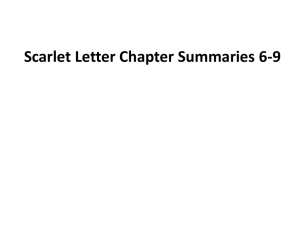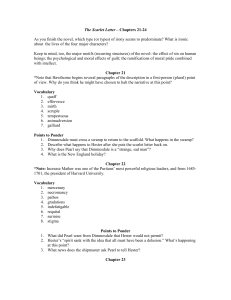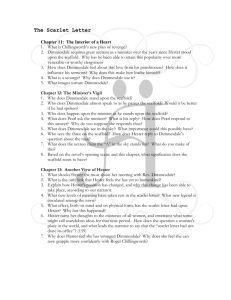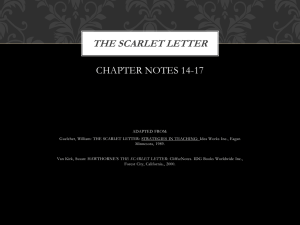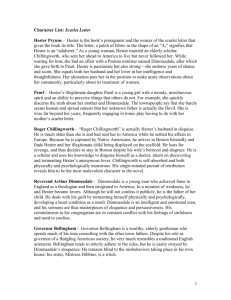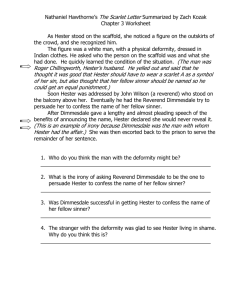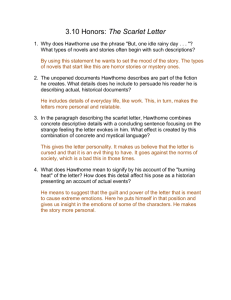The Scarlet Letter Study Guide Chp
advertisement
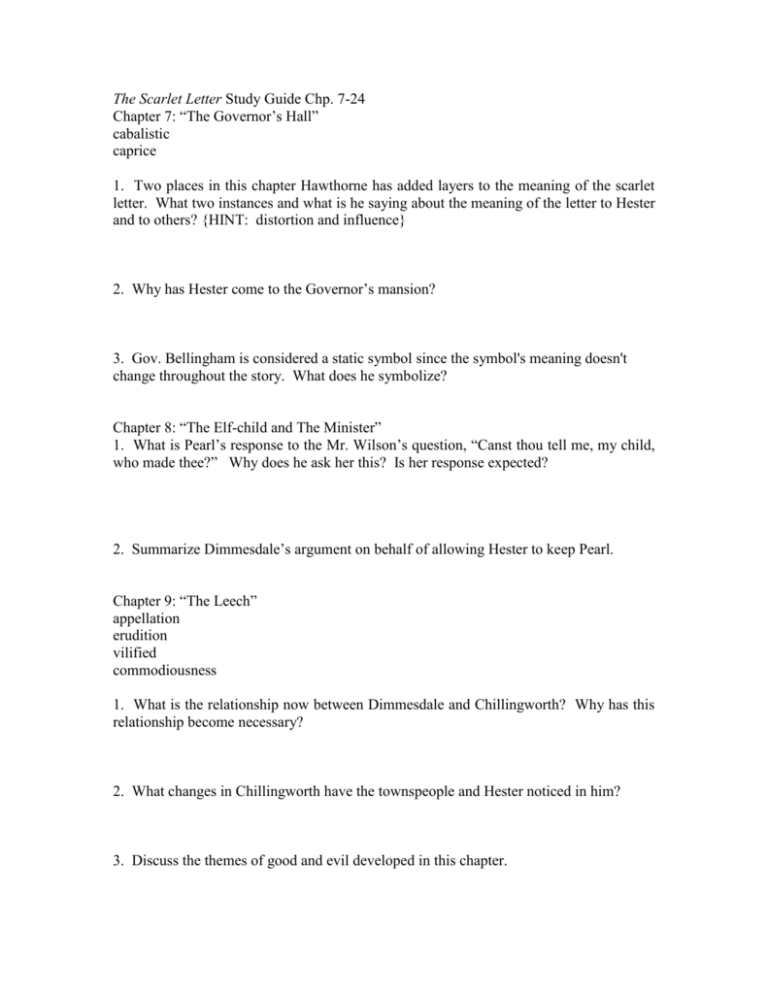
The Scarlet Letter Study Guide Chp. 7-24
Chapter 7: “The Governor’s Hall”
cabalistic
caprice
1. Two places in this chapter Hawthorne has added layers to the meaning of the scarlet
letter. What two instances and what is he saying about the meaning of the letter to Hester
and to others? {HINT: distortion and influence}
2. Why has Hester come to the Governor’s mansion?
3. Gov. Bellingham is considered a static symbol since the symbol's meaning doesn't
change throughout the story. What does he symbolize?
Chapter 8: “The Elf-child and The Minister”
1. What is Pearl’s response to the Mr. Wilson’s question, “Canst thou tell me, my child,
who made thee?” Why does he ask her this? Is her response expected?
2. Summarize Dimmesdale’s argument on behalf of allowing Hester to keep Pearl.
Chapter 9: “The Leech”
appellation
erudition
vilified
commodiousness
1. What is the relationship now between Dimmesdale and Chillingworth? Why has this
relationship become necessary?
2. What changes in Chillingworth have the townspeople and Hester noticed in him?
3. Discuss the themes of good and evil developed in this chapter.
4. The word “leech” is an old word for a physician. It also has these meanings: “a
bloodsucking worm formerly used by physicians in blood letting,” and “one who clings
to another to get what he can from him.” Explain the irony involved in using this word in
association with Chillingworth.
Chapter 10: “The Leech and His Patient”
somniferous
1. This chapter focuses on Chillingworth’s search to uncover what truly ails
Dimmesdale. Discuss each person’s argument about such disclosure.
2. While Dimmesdale is sleeping, what dark discovery does Chillingworth make?
Chapter 11: “The Interior of a Heart”
odious
1. What is the irony Hawthorne creates in this chapter with regards to Dimmesdale’s
sermon and his attempt at confession?
2. What is Chillingworth coming to personify in his all-consuming quest for revenge?
Chapter 12: “The Minister’s Vigil”
somnambulism
zenith
1. Where does Dimmesdale go and for what purpose?
2. What is Pearl’s request of Dimmesdale?
3. Discuss the role of the meteor?
4. Compare and contrast the first scaffold scene (7 years earlier) to this scaffold scene.
Chapter 13: “Another View of Hester”
despotic
1. Contrast Hester’s position in the community four years ago to her position in the
community now?
2. What has her scarlet A now come to symbolize?
3. What changes have been brought about in Dimmesdale and what has Hester resolved
to do because of these changes?
Chapter 14: “Hester and the Physician”
1. Chillingworth has certainly changed from a “kind, true, and just” man to a fiend who
does the devil’s work. That being said, how does Hester think Chillingworth can save
himself?
2. What does Hester say she will do?
Chapter 15: “Hester and Pearl”
sedulous
deleterious
malignant
precocity
asperity
petulant
1. Upon answering Pearl’s question, explain how Hester, for the first time, has “been
false to the symbol on her bosom.”
Chapter 16: “A Forest Walk”
scintillating
loquacity
1. How is the brook personified?
2. What role does the dark forest play in this chapter?
Chapter 17: “The Pastor and His Parishor”
misanthropy
contiguity
1. When Hester and Dimmesdale meet in the woods, he asks her if she had found peace.
How does she reply? How does he answer the same question?
2. The themes of love, redemption, and forgiveness begin to emerge in this chapter.
Hawthorne asks the reader to consider 1) who has violated God’s law with sure and
certain knowledge?, and 2)Whose place is it to provide redemption and forgiveness?
What does Hester say about these questions? What does Dimmesdale think?
3. How is Hester characterized in this chapter? Support your ideas through her words
and actions as well as through Dimmesdale’s response to her words and actions.
Chapter 18: “A Flood of Sunshine”
1. What change comes about Hester when she removes the letter?
2. In this chapter, Hawthorne uses the scenery and setting (Nature) to enhance the theme
of redemption. How does he do this?
Chapter 19: “The Child at the Bookside”
1. In order to be able to love freely, Hester and Dimmesdale must meet with Pearl’s
approval. What is Pearl’s reaction to meeting them together? How do Hester and
Dimmesdale respond?
2. Why do you think Pearl has responded to them in such a way? Keep in mind, Pearl is
one with nature and the wilderness. What may appear “unnatural” to her? Is her reaction
unnatural?
Chapter 20: “The Minister in a Maze”
1. How has Dimmesdale changed since his meeting with Hester in the forest? Consider
each of the following boxes:
In his physical state…
In his demeanor and
actions…
In his conversation
with Chillingworth…
In
his
religious
conviction…
Chapter 21: “The New England Holiday”
1. Hawthorne uses satire when he comments that, on the most festive day, the people,
“compressed whatever mirth and public joy they deemed allowable to human infirmity;
thereby so far dispelling the customary cloud, that, for the space of a single holiday, they
appeared scarcely more grave than most other communities at the period of general
affliction.” What is he saying about the holiday and the Puritan society?
2. What does Hester find out about Chillingworth? How does this keep in line with his
character?
Chapter 22: “The Procession”
1. What role does Mistress Hibbins play in this chapter?
Chapter 23: “The Revelation of the Scarlet Letter”
1. This chapter shows the third scaffold scene. What occurs during this scene?
2. In what ways is Dimmesdale’s sermon a personal triumph?
Chapter 24: “Conclusion”
1. Hawthorne writes this chapter with ambiguity and vagueness. In what way is he
ambiguous with regards to Dimmesdale’s confession on the scaffold? Why do you think
Hawthorne does this?
2. What is the moral of the story? Specific lines to explain.
3. Consider Pearl and Dimmesdale’s final encounter from chapter 23. What occurs that
tells us Pearl will grow up to be humane?
4. What happens to Chillingworth? What ironically does he say about love and hate?
Do you agree?
5. What does Chillingworth do for Pearl? Why do you think he does this?
6. Hester and Pearl do eventually leave Boston to live in Europe. However, Hester
returns to Boston and resumes wearing the scarlet letter. WHY would she do this? Is it a
sign that she accepts the rigid standards of Puritan society, or is it a sign that she stayed
true to herself by daring to live beyond the petty rules of Puritan society?
7. What is ironic about the deaths of Hester and Dimmesdale and the tombstone they
share?
Small Group Activity
1. Consider the sins of the three major characters. Whose sin is the greatest? Why?
2. In your opinion, is it better to confess or not? Use evidence from the story,
specifically the choices made by Hester and Dimmesdale and their results.
Final Group Discussion:
Is Arthur Dimmesdale a remarkably strong character to have carried his burden of guilt
for so many years? Or was he weak for not having the courage to confess? Given what
you know about him, would he have been able to “run away” with Hester and Pearl and
start a new life? Discuss these issues with members of your group. Be ready to cite
evidence from the text to support your opinions.

